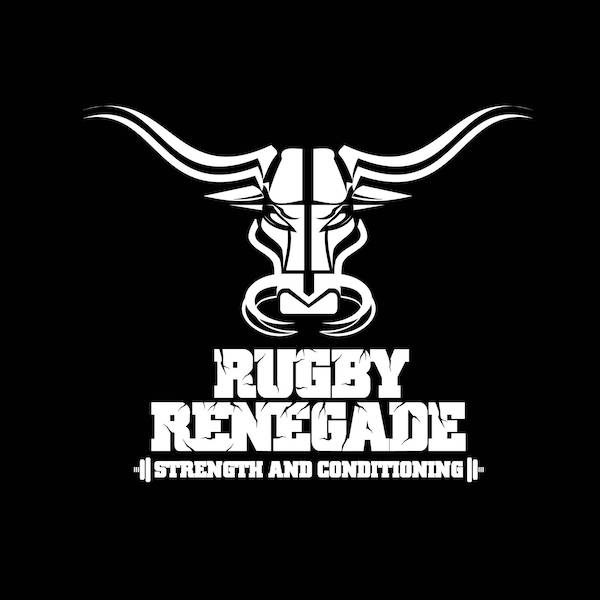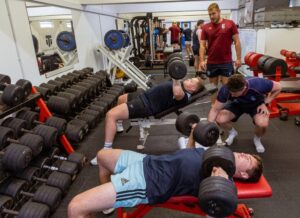PLYOMETRICS FOR RUGBY
Where does it fit in?
The ultimate outcome of a strength program is to develop peak power output in essential movement patterns. Power output consists of both strength and speed qualities and to develop power a player would need to address both sides of the coin. If we look at the force-velocity curve, it could be divided into five sections:
- Max Strength
- Strength-Speed
- Explosive Power (Peak power)
- Speed-Strength
- Reactive Strength or Speed
If our goal is to develop peak power, we should address the training qualities at the top end (Strength & Strength-Speed) & bottom end (Speed-Strength & Reactive-Strength) of the curve. Initially, all players will get more powerful by getting stronger, but there is a place in which more strength does not equal more power. This is when training speed qualities are essential for players to keep improving their power output and can express their strength on the playing field. One of the best methods for training speed in the weight room is through jumping & plyometrics.
This does however not mean that you should only start a jump program once you have sufficient strength. You should be training both at the same time from the moment you start your strength training program. There is a popular belief out there that a player should have reached a certain strength level before he could start a plyometric program. I don’t agree with this.
Firstly, plyometric require the development of both motor potential (intra-muscular coordination) and technical mastery (intermuscular coordination). The motor potential is developed through high-intensity plyometrics, but technical mastery is done through low impact extensive jumps. Before a player can progress to more high-intensity plyometrics like drop jumps and repeated hurdle jumps, they need to lay the foundation of fluidity, precision and control. This is a vastly underutilised element of power development since improving movement skill will not only reduce the risk of injuries, it will improve power without an increase in effort and is very easy to train and don’t need recovery.
The second reason I don’t believe a player should reach a certain strength level before he can do plyometrics is that of the principle of progression. In my view, any exercise is safe if a player has been systematically exposed to it in a safe progressive manner. On the contrary, it would be much more dangerous to take a 2.5 x BW squatter that has never jumped in his life and do plyo’s with him than my 16-year-old who has been in the gym for 6 months and followed and progressive plyometric program with good technique.
Difference between Jumps & Plyo’s
Plyometric depend largely on the utilisation of the stretch-shortening cycle (SSC), stiffness and relaxation. SSC is storage and utilization of elastic energy, increase motor unit recruitment and the reflex mechanism from muscle spindles
For the muscle spindle reflex to be initiated, a fast rate of eccentric stretching must occur. For elastic energy to contribute, there must be a short transition period between the eccentric and concentric phases and for enhanced motor unit recruitment to contribute, there must be a fast eccentric phase and a short transition period between the eccentric and concentric phases. This stimulus can only occur with drop jumps and depth jumps in which the landing from the jump stimulates significant eccentric stretching and activation of the muscle spindles.
Jump training, on the other hand, can be defined as an “acceleration of a high velocity through the whole ROM, and with actual projection into free space”. The goal is to produce peak power and it depends on both SSC & strength qualities
German Sports Scientist Dr Dietmar Schmidtbleicher suggested the SSC can be classified as either slow or fast.
Fast SSC is characterized by short contraction or ground contact times (<0.25sec), with small angular displacement (ankle, knee, hip). Springy reactive jumps like depth jumps or repeated hops in place is an example of this Slow SSC involves longer contraction times (>0.25 seconds), larger angular displacements, and is observed in maximal effort vertical jumps.
What do rugby players need?
So, what is better for rugby, fast or slow SSC? Research lean towards slow SSC being related to acceleration while fast SSC is related to maximal speed. Based on this evidence one would think that positions closer to the scrum would require more acceleration (Slow SSC) and the outside back more max speed (Fast SSC).
Rugby is a running based sport and require players to accelerate, sprint and overcome external resistance all the time. There is very little pure sprinting and pure out of the block acceleration happening in the game and being able to produce slow SSC and fast SSC should be interchangeable for all positions at any given time. Therefore, I would program both methods into my strength program for all players. This does not mean that all rugby strength programs should look the same for all players. There should be a distinction between the training need of a player. As mentioned earlier, it’s all about producing power and the question is what does a player need to make him more powerful?
Evaluating the training need
There is an easy 3 step process one can use to assess if a player need a strength, slow SSC or fast SSC dominant program.
Firstly, are you strong enough? For me personally, I would prioritise a players’ strength first. This underpins all physical capabilities on the F-V curve and you get the quickest, the most sustainable adaptation from it. I would still address a player’s reactive strength (fast & slow SSC), but to a lesser extent. Once a player reaches a certain level of strength (Squat 2.2-2.5 x BW), my attention will move towards more reactive strength.
Secondly, can you jump explosively (slow SSC)? This can be done with a simple countermovement jump (CMJ). The metric you are looking for is a jump height of about 50-60cm or velocity of 2.2-2.4 m/sec.
Once you have achieved optimal jump performance, you now can evaluate if you can jump fast enough (fast SSC). This can be done by doing a drop jump with quick contact time. Research show that an increase of 10% from CMJ to drop jump is an indication that a person has good fast SSC ability. If it’s below 10%, then more attention should be given to fast SSC in the program.
Just a technical note. If you perform a drop jump, the ideal will be to do it on a reaction matt to see your ground contact time. You should be able to reach 10% better score with a ground contact time below 250ms. If you don’t have access, don’t sweat it. Just get off the ground as fast as possible.
Below is a breakdown of how I would program for individual players based on their training needs.
About Nico de Villiers
Nico is an NSCA Certified Strength and Conditioning Specialist with a Master’s degree in Sport Science (Optimal training loads for peak power output). He has 10-years experience as a full time S&C coach in various levels of rugby as well as a stint in netball. He has paid his dues in professional rugby as a player (won the Junior world cup with baby boks 2003), a coach and a trainer. The last couple of years he has been serving the Boland rugby institute, SA rugby academy and currently strength coach at Stormers & WP rugby.
In his spare time he’s been involved with lecturing at the Sport Science department Stellenbosch University, presenting conditioning workshops and been part of the world rugby coaching education panel. He has also launched a new rugby strength and conditioning website that he writes regular articles on: Rugby Strength & Conditioning South Africa.






